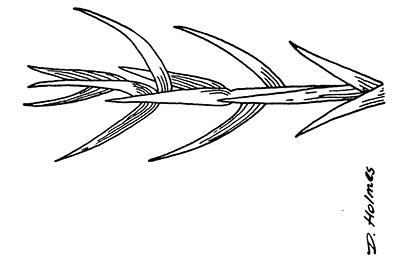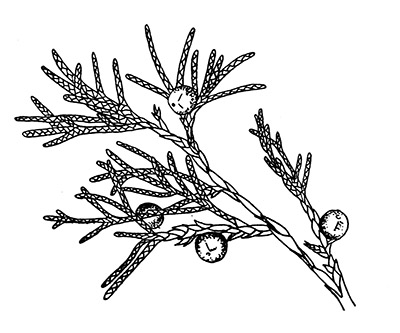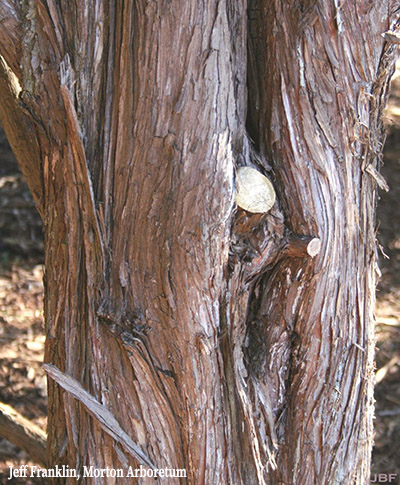Intro to Trees of Indiana: Eastern Red Cedar
The classic and trusted book "Fifty Common Trees of Indiana" by T.E. Shaw was published in 1956 as a user-friendly guide to local species. Nearly 70 years later, the publication has been updated through a joint effort by the Purdue Department of Forestry and Natural Resources, Indiana 4-H, and the Indiana Department of Natural Resources, and reintroduced as "An Introduction to Trees of Indiana."
A printed copy of the full publication is available for purchase for $7 in the Purdue Extension Education Store. The field guide helps identify common Indiana woodlot trees.
Each week, the Intro to Trees of Indiana web series will offer a sneak peek at one species from the book, paired with an ID That Tree video from Purdue Extension forester Lenny Farlee to help visualize each species as it stands in the woods. Threats to species health as well as also insight into the wood provided by the species, will be provided through additional resources as well as the Hardwoods of the Central Midwest exhibit of the Purdue Arboretum, if available.
This week, we meet Eastern red cedar or Juniperus virginiana, one of the most common coniferous trees in Indiana.
Indiana.
This evergreen tree, also known as aromatic cedar, is unique in that it has both scale-like and sharp-pointed leaves. The foliage can be soft to the touch on mature trees or be quite sharp in seedlings and younger trees. The foliage turns from green to blueish green in spring to red or brown in winter.
The red cedar features a shreddy bark on both the trunk and branches, which is gray brown in color. It is slow growing but may live longer than 450 years.
The fruit of red cedar is a small cone, which resembles and is often referred to as a berry, that is blue in color and features a whitish bloom on the surface. The fruit is preferred by birds and wildlife of many varieties and is thus spread to roadsides, old pastures and other locations with plenty of sun and disturbed soil. It can be found in forest understories, but prefers direct sunlight.
According to the U.S. Forest Service database, the eastern red cedar, which can grow to 40 to 50 feet tall, is native to the eastern United States and Canada. Its range extends from Nova Scotia west to Ontario, south through the northern Great Plans to eastern Texas and east from northern Florida and up the Atlantic Coast. It is adaptive to alkaline soils, road salt and occasional drought. Eastern red cedar may be found in varied habitats from deep and shallow soils on ridgetops and in valleys to thin, rock soils and dry outcrops to saturated soils of swamps.
The Morton Arboretum warns that cedar rusts, such as cedar-apple, cedar-hawthorn and cedar-quince), and bagworms are common problems for this species. It also states that red cedars grow best in full sun, but are adaptable to soils with high pH and tolerant of dry windy conditions once trees are established.
The Wood Database notes that eastern red cedar has a 12 percent moisture content and weights in at 33 pounds per cubit foot. This species glues and finishes well, although the wood is often left unfinished to preserve its aromatic properties.
The wood is dark red in color and very aromatic, which can repel moths and other insects. This decay resistant wood is often used to make cedar closets and the cedar lining of cabinets and chests. Red cedar also can be used for fence posts, carvings, outdoor furniture, birdhouses, pencils, bows and small wooden specialty items.
Other Resources:
ID That Tree: Eastern Red Cedar
Morton Arboretum: Eastern Red Cedar
Fruit Diseases: Cedar Apple and Related Rusts on Apples in the Home Landscape
Diseases of Landscape Plants: Cedar Apple and Related Rusts on Landscape Plants
Purdue Arboretum Explorer
The Woody Plant Seed Manual, U.S. Forest Service
Purdue Plant Doctor
Native Trees of the Midwest, The Education Store
Shrubs and Woody Vines of Indiana and the Midwest, The Education Store
Investing in Indiana Woodlands, The Education Store
Forest Improvement Handbook, The Education Store
ID That Tree, Purdue Extension-Forestry & Natural Resources (FNR) YouTube playlist
Woodland Management Moment , Purdue Extension-FNR YouTube playlist






